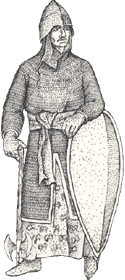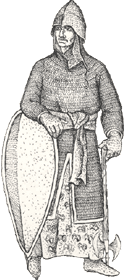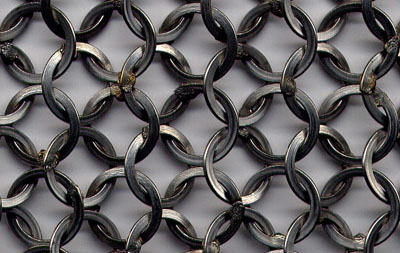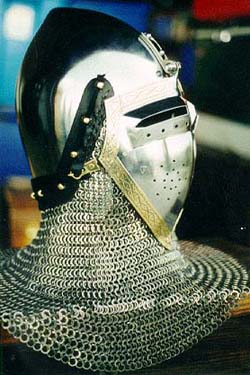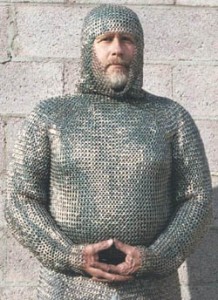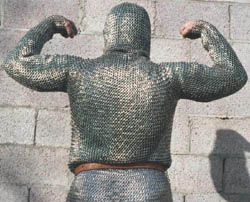Overview
We offer a variety of chainmail products, including custom orders.
Our standard
chainmail weave using the Stainless Steel Flat Wire.
Our chainmail is assembled in the U.S.A. and Viet Nam from links made in the U.S.A. Our chainmail is always welded. The metal types we carry are Titanium and Stainless Steel. We also carry Silicon Bronze and Mild Steel on special order, they are always priced the same as Stainless Steel. We offer 3 kinds of wire types. Flat wire is .030 x .055 with an inside diameter of 5/16, available in Titanium and Stainless Steel. Round Wire .045 with an inside diameter of 5/16, available in Titanium and Stainless Steel. Round Wire .063 with an insidediameter of 3/8, available in Stainless Steel.
Aventaille (Also aventail, camaille, camail)
Originally a guard of mail for the neck and shoulders worn fastened to the bascinet during the 14th Century. In modern times, it has been adapted to many other helmet types from other historic periods and places. My long aventails consist of a truncated cone which covers the shoulders surmounted by a cylindrical section which extends upward. The base of the cone is 54 inches in circumference and the cylinder is 6 inches in height and 32 inches in circumference. The cylindrical section provides a place where materiel can be trimmed away so as to fit the aventail to the widest possible range of helmet styles and face shapes. My short aventails consist of just the conic section and are suitable for those helmets where the bottom rim of the helmet is continuous with the bottom edge of a permanent face grill.
Shirt (aka Byrne or Hauberks)
Prices are dependent on size and style as well as material type. All measurements must be taken over your gambeson, under garb, extra padding, favors, good luck charms and/or anything that you will be putting under your chainmail.
For a hauberk, I will need to know:
- Chest circumference at the armpits (relaxed stance). Check down the torso to verify that this is the largest circumference of the torso. If the stomach and/or waist are larger than the chest, their circumferences must also be recorded.
- Front from the front of the right armpit to the front of the left armpit along the same line as the circumference.
- Back from the back of the right armpit to the back of the left armpit along the circumference line.
- Armpit from the front to the back along the circumference line . (Note: The sum of the front, back and twice the armpit measurements should roughly equal the chest measurement.).
- Shoulder from the front of the armpit (same starting point as for #3) over the top of the shoulder to the back of the armpit (same end point as for #3) with the arm extended horizontally. It is *very* important that any bunching, doubling or folding of your gambeson that might occur be included in this measurement.
- Bicep circumference at its largest (arm flexed and tensed).
- Arm length (for short sleeves) from the line through the armpit to the desired end of the arm. —or— Arm length (for long sleeves) from the line through the armpit to the bony knob on the underside of the elbow. (Long Sleeves will add about $150 to the price of the Shirt)
- Forearm length from the bony knob under the elbow to the desired cuff location.
- Elbow circumference A) straight and B) flexed 90 degrees.
- Forearm circumference taken just below the elbow.
- Hand circumference the smallest opening through which the hand can pass easily.
- Head circumference the smallest opening through which the head can pass easily.
- Fall length from the line through the armpit to the desired hem line. I will also need to know what shoulder design you prefer.
I have 3 options for type of shoulder design.
- The Classic 90 degree shoulder which is the form used on every surviving piece of historic mail. The arms are set at 90 degrees to the torso. The rows of rings run seamlessly across the chest and along the length of the arm.
- The Modern 45 degree seam form in which the arms are set at about 80 degrees to the torso (about like a modern ‘T’ shirt) with the rows of rings running around the circumference of the arm.
- The Mantle form is a best guess reconstruction of a shoulder design sometimes depicted in 11th and 12th century paintings. The circumferential rows of the torso merge seamlessly into the circumferential rows of the arms. The arms can be set at any angle to the torso from 70 degrees to 120 degrees according to the preferences of the customer. It is more expensive ($200 extra) than the other forms because of the extra care and labor needed in fitting.
When I get your measurements, I will e-mail you a firm price quote for your approval.
I will not require a deposit but I will ask for payment in full (certified check, e-transfer or COD are all acceptable) prior to delivery. FedEx ground shipping costs for customers in the continental US or by USPS for customers outside the continental US will be included. All duties, taxes or local service charges for shipments outside the US are the customer’s responsibility.
For additional information, please contact me.
